Abstract
The possible teratogenic effect of drugs used in veterinary medicine is important for two main reasons: safety for the target animals and residue risks for the consumers of animal products.
The general laws of chemical teratogenesis are: specific sensitivity, smallness of the teratogenic dose, existence of a sensitive period, and single dose effect. They are illustrated by different examples in domestic animals. In most cases (retinol, griseofulvin), the teratogenic doses are obviously higher than the therapeutic ones; on the contrary, in some circumstances (parbendazole, cambendazole), the safety margin is relativley low and requires strict observance of the recommended dosage.
It is pointed out that metabolism is a determining factor of teratogenesis and is related to drug residue toxicity. Yet, it is experimentally possible to distinguish inactive metabolites and teratogenic metabolites that may be present in meat and milk. Consequently, a more appropriate evaluation of risks is possible, compared to the classical method that uses total radioactivity levels. These nitions are illustrated by numerous examples of anthelmintics.
Similar content being viewed by others
References
Becker, W., 1976. Die Bewertung von Rückständen nach Anwendung von Panacur. Berl. Münch. Tierärztl. Wschr., 89: 453–456.
Bell, J.P. and Tomlinson, R.V., 1976. Metabolites of a new anthelmintic agent, Oxfendazole. Fed. Proc., 35: 487.
Binns, W., Shupe, J.L., Keeler, R.F. and James, L.F., 1965. Chronologic evaluation of teratogenicity in sheep fedVeratrum californicum. J.A.V.M.A., 147: 839–842.
Delatour, P. and Richard, Y., 1976. Propriétés embryotoxiques et antimitotiques en série benzimidazole. Thérapie, 31: 505–515.
Delatour, P., Lorgue, G., Courtot, D. et Lapras, M., 1975. Embryotoxicité expérimentale du Cambendazole chez le mouton. Bull. Soc. Sci. Vet. & Med. Comp. de Lyon, 77: 197–203.
Delatour, P., Lorgue, G., Courtot, D. et Lapras, M., 1976. Tolérance embryonnaire de l'Oxibendazole chez le Rat et le Mouton. Rec. Med. Vet., 152: 467–470.
Delatour, P., Debroye, J., Lorgue, G. et Courtot, D., 1977. Embryotoxicité expérimentale de l'oxfendazole chez le Rat et le Mouton. Rec. med. Vet., 153: 639–645.
Di Cuollo, C.J., Miller, J.A., Mendelson, W.L. and Pagano, J.F., 1974. Metabolic and tissue residue studies on Parbendazole in sheep. J. Agric. Food Chem., 22: 948–953.
Douch, P.G.C., 1974. The metabolism of some thioureidobenzene fungicides in mice and sheep. Xenobiotica, 4: 457–475.
Grannec, C., 1980. Albendazole: Embryotoxicité de relais (Comparaison avec l'embryotoxicité de dix métabolites). Thèse Doct. Vet. Lyon.
Gyurik, R.J., Chow, A.W., Zaber, B., Brunner, E.M., Miller, J.A., Villani, A.J., Petka, L.A. and Parish, R.C., 1981. Metabolism of Albendazole in cattle, sheep, rats and mice. Drug Met. Disp., 9: 503.
Marriner, S.E. and Bogan, J.A., 1980. Pharmacokinetics of albendazole in sheep. Am. J. Vet. Res., 41: 1126–1129.
Martin, D., 1980. Albendazole: Etude embryotoxique de dix métabolites (Comparaison avec l'embryotoxicité de relais). Thèse Doct. Vet. Lyon.
Mayo, B.C., Brodie, R.R., Chasseaud, L.F. and Hawkins, D.R., 1978. Biotransformation of methyl 5-cyclopropylcarbonyl-2-benzimidazolecarbamate (Ciclobendazole) in rats and dogs. Drug Met. Disp., 6: 518–527.
Meuldermans, W.E.G., Hurkmans, R.M.A., Lauwers, W.F.J. and Heykans, J.J.P., 1976. The in vitro metabolism of mebendazole by pig, rat and dog liver fractions. Europ. J. Drug Met. Pharamc., 1: 35–40.
Middleton, H.D., Plant, J.W., Walker, C.E., Dixon, R.T. and Johnson, D.R., 1974. The effect of Parbendazole on reproduction in sheep and other animals. III. Teratological study in ewes in Australia. Cornell Vet., 64: suppl.no. 4, 56–58.
Shone, D.K., Philip, J.R. and Fricker, J.M., 1974. The effects of Parbendazole on reproduction in sheep and other animals. IV. Teratological study in ewes in the Republic of South Africa. Cornell Vet., 64: suppl.no. 4, 69–76.
Szabo, T.K., Miller, C.R. and Scott, G.C., 1974. The effects of Parbendazole on reproduction in sheep and other animals. II. Teratological study in ewes in the United States. Cornell Vet., 64: suppl.no. 4, 41–55.
Theodorides, V.J., Di Cuollo, C.J., Nawalinski, T., Miller, C.R., Murphy, J.R., Freeman, J.F., Killeen, J.C. and Rapp, W.R., 1977. Toxicologic and teratologic studies of oxibendazole in ruminants and laboratory animals. Am. J. Vet. Res., 38: 809–814.
Author information
Authors and Affiliations
Rights and permissions
About this article
Cite this article
Delatour, P. Some aspects of the teratogenicity of veterinary drugs. Vet Res Commun 7, 125–131 (1983). https://doi.org/10.1007/BF02228606
Issue Date:
DOI: https://doi.org/10.1007/BF02228606




